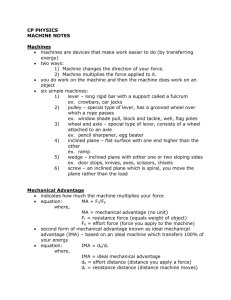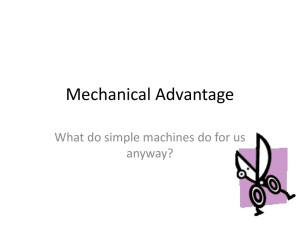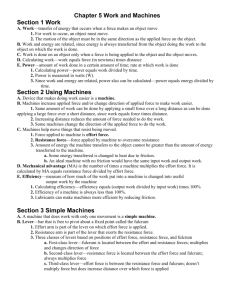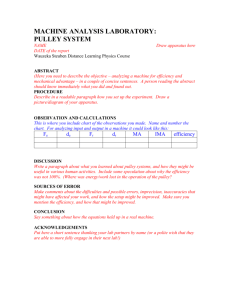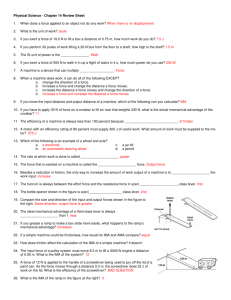Work, Power, and Machines: Physics Presentation
advertisement
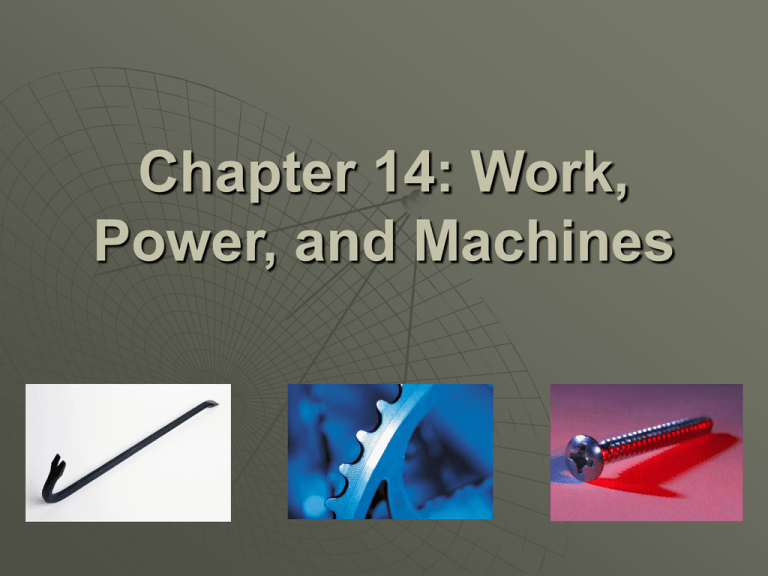
Chapter 14: Work, Power, and Machines Section 14.1 – Work and Power In science, work is the product of force and distance. Work is done when a force acts on an object in the direction the object moves. For a force to do work on an object, some of the force must act in the same direction as the object moves. If there is no movement, no work is done. Diagonal Forces A force does not have to act entirely in the direction of movement to do work. Any part of a force that does not act in the direction of motion does no work on an object. What is Work? 1. A scientist delivers a speech to an audience of his peers. NO 2. A body builder lifts 350 pounds above his head. YES 3. A mother carries her baby from room to room. NO 4. A father pushes a baby in a carriage. YES 5. A woman carries a 20 kg grocery bag to her car? NO Formula for Work W=Fxd work = force x distance The unit of force is newtons. The unit of distance is meters. The unit of work is newton-meters. One newton-meter is equal to one joule (J). Sample Problem 1. If a man pushes a concrete block 10 meters with a force of 20 N, how much work has he done? d = 10m F = 20N W=? W=Fxd W = 20N x 10m = 200J Power Power is the rate at which work is done. Doing work at a faster rate requires more power. To increase power, you can increases the amount of work done in a given time, or you can do a given amount of work in less time. Formula for Power P = W/t Power = work/time The unit of work is a Joule, and the unit of time is a second. A joule per second is a watt (W) which is the SI unit for power. Sample Problems 1.Two physics students, Ben and Bonnie, are in the weightlifting room. Bonnie lifts the 50 kg barbell over her head (approximately .60 m) 10 times in one minute; Ben lifts the 50 kg barbell the same distance over his head 10 times in 10 seconds. Which student does the most work? Which student delivers the most power? Sample Problems 2. How much work does a 25N force do to lift a potted plant from the floor to a shelf 1.5m high? W=? F = 25N d = 1.5m W=Fxd W = 25N x 1.5m = 37.5J 3. How much force is needed to complete 72.3J of work over a distance of 22.8m? F=? W = 72.3J D = 22.8m W=Fxd F = W/d F = 72.3J = 3.17N 22.8m Sample Problems 4. You exert a vertical force of 72N to lift a box to a height of 2m in a time of 17s. How much power is used to lift the box? F = 72N d = 2m t = 17s P=? W=Fxd W = 72N x 2m = 144J P = W/t P = 144J/17s = 8.47W 5. You lift a book from the floor to a bookshelf 5.4m above the ground. How much power is used if the upward force is 15.0N and you do the work in 2.0s? d = 5.4m F = 15.0N t = 2.0s P=? W=Fxd W = 15.0N x 5.4m = 81J P = W/t P = 81J/2.0s = 40.5W Section 14.1 Assessment 1. What conditions must exist in order for a force to do work on an object? 2. What formula relates work and power? 3. How much work is done when a vertical force acts on an object moving horizontally? 4. A desk exerts an upward force on a computer resting on it. Does this force to work? Section 14.1 Assessment 5. You lift a large bag of flour form the floor to a 1m high counter, doing 100J of work in 2s. How much power do you use to lift the bag of flour? W = 100J t = 2s P=? P = W/t P = 100J = 50W 2s Section 14.2 – Work and Machines A machine is a device that changes a force. Machines make work easier to do. They change the size of the force needed, the direction of a force, or the distance over which a force acts. Increasing Force Each complete rotation of a car jack handle applies a small force over a large distance. A small force over a large distance becomes a large force over a small distance. If a machine increases the distance over which you exert a force, then it decreases the amount of force you need to exert. Increasing Distance When you pull an oar a small distance, the other end of the oar moves a large distance through the water. A machine that decreases the distance through which you exert a force increases the amount of force required. Changing Direction Pulling on end of an oar causes the other end of the oar to move in the opposite direction. Work Input Because of friction, the work done by a machine is always less than the work done on the machine. The force you exert on a machine is called the input force. The distance the input force acts through is known as the input distance. The work done by the input force acting through the input distance is called the work input. Work Output The force that is exerted by a machine is called the output force. The distance the output force is exerted though is the output distance. The work output of a machine is the output force multiplied by the output distance. You cannot get more work out of a machine than you put into it. Section 14.2 Assessment 1. How can using a machine make a task easier to perform? 2. How does the work done on a machine compare to the work done by a machine? 3. A machine produces a larger force than you exert. How does the input distance of the machine compare to the output distance? Section 14.2 Assessment 4. You do 200J of work pulling the oars of a rowboat. What can you say about the amount of work the oars doe to move the boat? 5. How can you increase the work output of a machine? 6. When you swing a baseball bat, how does the output distance the end of the bat moves compare with the distance you move your hands through? Section 14.3 – Mechanical Advantage and Efficiency The mechanical advantage of a machine is the number of times that the machine increases the input force. The actual mechanical advantage (AMA) is the ratio of the output force to the input force. AMA = output force input force Ideal Mechanical Advantage The ideal mechanical advantage (IMA) of a machine is the mechanical advantage in the absence of friction. Because friction is always present, the actual mechanical advantage is always less than the ideal mechanical advantage. Ideal Mechanical Advantage The ideal mechanical advantage (IMA) is the ratio of the input distance to the output distance. IMA = input distance output distance Sample Problems 1. A woman drives a car up a ramp that is 1.8m long. The ramp lifts the car a height of 0.3m. What is the IMA? input distance = 1.8m output distance = 0.3m IMA = ? IMA = input distance output distance IMA = 1.8m = 6 0.3m Sample Problems 2. A construction worker moves a crowbar through a distance of 0.50m to lift a load 0.05m off the ground. What is the IMA of the crowbar? input distance = 0.50m output distance = 0.05m IMA = ? IMA = input distance output distance IMA = 0.50m = 10 0.05m 3. The IMA of a simple machine is 2.5. If the output distance of the machine is 1.0m, what is the input distance? IMA = 2.5 output distance = 1.0m input distance = ? IMA = input distance / output distance input distance = IMA x output distance input distance = 2.5 x 1.0m = 2.5m Efficiency Some output force is lost due to friction. The percentage of work input that becomes work output is the efficiency of the machine. No machine has 100 percent efficiency due to friction. Formula for Efficiency Efficiency = work output x 100 work input Reducing friction increases the efficiency of a machine. Section 14.3 Assessment 1. Why is the actual mechanical advantage of a machine always less than its ideal mechanical advantage? 2. Why can no machine be 100% efficient? 3. What information would you use to calculate the efficiency of a machine? 4. What is the actual mechanical advantage of a machine that exerts 5N for each 1N of force you exert on the machine? AMA = ? output force = 5N input force = 1N AMA = output force / input force AMA = 5N / 1N = 5 Section 14.3 Assessment 5. You have just designed a machine that uses 1000J of work from a motor for every 800J of useful work the machine supplies. What is the efficiency of your machine? work input = 1000J work output = 800J Efficiency = ? Efficiency = work output x 100 work input Efficiency = (800J / 1000J) x 100 = 80% 6. If a machine has an efficiency of 40%, and you do 1000J of work on the machine, what will be the work output of the machine? Efficiency = 40% Efficiency = work output x 100 work input = 1000J work input work output = ? work output = (Efficiency x work input) / 100 work output = (40% x 1000J) / 100 = 400J Section 14.4 – Simple Machines Many mechanical devices are combinations of two or more of the six different simple machines. The six simple machines are: The Lever A lever is a rigid bar that rotates around a fixed point called the fulcrum. The input arm of a lever is the distance between the input force and the fulcrum. The output arm is the distance between the output force and the fulcrum. 3 Classes of Levers The class of a lever is determined by the location of the effort force and the load relative to the fulcrum. First Class Levers In a first-class lever the fulcrum is located at some point between the effort and resistance forces. Common examples of first-class levers include crowbars, scissors, pliers, tin snips and seesaws. A first-class lever always changes the direction of force (I.e. a downward effort force on the lever results in an upward movement of the resistance force). First Class Lever Fulcrum is between EF (effort) and RF (load) Second Class Lever With a second-class lever, the load is located between the fulcrum and the effort force. Common examples of second-class levers include nut crackers, wheel barrows, doors, and bottle openers. A second-class lever does not change the direction of force. When the fulcrum is located closer to the load than to the effort force, an increase in force (mechanical advantage) results. Second Class Lever RF (load) is between fulcrum and EF Third Class Lever With a third-class lever, the effort force is applied between the fulcrum and the resistance force. Examples of third-class levers include tweezers and sweeping. A third-class lever does not change the direction of force; third-class levers always produce a gain in speed and distance and a corresponding decrease in force. Third Class Lever EF is between fulcrum and RF (load) Wheel and Axle The wheel and axle is a simple machine consisting of a large disk (wheel) rigidly secured to a smaller disk (axle). To calculate the IMA, divide the radius where the input force is located by the radius where the output force is located. Inclined Plane An inclined plane is a slanted surface along which a force moves an object to a different elevation. Inclined Plane The mechanical advantage of an inclined plane is equal to the length of the slope divided by the height of the inclined plane. While the inclined plane produces a mechanical advantage, it does so by increasing the distance through which the force must move. Wedge The wedge is a V-shaped object whose sides are two inclined planes. A thin wedge of a given length has a greater IMA than a thick wedge of the same length since less force is needed. Screw The screw is an inclined plane wrapped around a cylinder. Screws with threads that are closer together have a greater IMA since it takes less force. Pulley A pulley is a simple machine that consists of a rope that fits into a groove in a wheel. A pulley can be used to simply change the direction of a force or to gain a mechanical advantage, depending on how the pulley is arranged. The IMA of a pulley is equal to the number of ropes sections supporting the load being lifted. Pulley A pulley is said to be a fixed pulley if it does not rise or fall with the load being moved. A fixed pulley changes the direction of a force; however, it does not create a mechanical advantage. A moveable pulley rises and falls with the load that is being moved. A single moveable pulley creates a mechanical advantage; however, it does not change the direction of a force. Movable pulleys are used to reduce the input force needed to lift a heavy object. Pulley Movable Pulley Fixed Pulley Combined Pulley Compound Machines A compound machine is a combination of two or more simple machines that operate together. Section 14.4 Assessment 1. Name six kinds of simple machines. Give an example of each. 2. What is the ideal mechanical advantage of a ramp if its length is 4.0m and its higher end is 0.5m above its lower end? IMA = ? input distance = 4.0m output distance = 0.5m IMA = input distance output distance IMA = 4.0m = 8 0.5m Section 14.4 Assessment 3. Tightening a screw with a larger spacing between its threads requires fewer turns than a screw with smaller spacing. What is the disadvantage to using a screw with a larger spacing between threads? 4. If you want to pry the lid off a pint can, will it require less force to use a long or short screwdriver? Section Assessment 14.4 5. When the pedals of a bike move through a distance of 0.25m, the rear wheel of the bike moves 1.0m. What is the ideal mechanical advantage of the bike? input distance = 0.25m output distance = 1.0m IMA = ? IMA = input distance output distance IMA = 0.25m = 0.25 1.0m THE END
